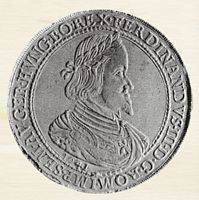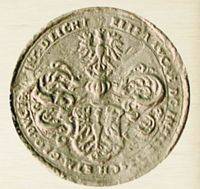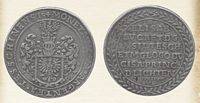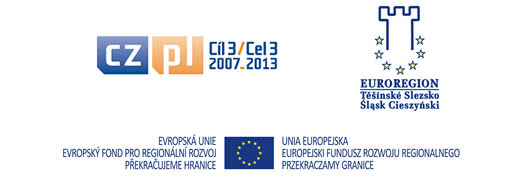The rule of Princess Elizabeth Lucretia (1625-1653)
The death of Prince Frederick William in 1625 caused another break in the work of the Cieszyn mint. He left his sister, Elizabeth Lucretia, the Duchy of Cieszyn in his will, yet Bohemian feudal law did not grant women the right of succession. Finally at the end of 1638 Emperor Ferdinand III Habsburg, King of Bohemia, agreed to the Princess's right to rule the Cieszyn Duchy until the end of her life, also confirming her right to mint her own coin. However, the position of Elizabeth Lucretia was much weaker than that of her ancestors. Her rule was an exception to the principle, and had no chance of bequeathing it to her children from her marriage to Prince Gundaker of Liechtenstein. The necessity to submit to the Emperor's will is clearly evident on coinage minted by Elizabeth Lucretia. Most of them bore the bust of Ferdinand III and his imperial titles on the obverse, and only the reverse featured the coat of arms of the Cieszyn Duchy. Besides, the coins were minted according to the regulations binding in the Lands of the Crown of St. Wenceslas and Silesia. The Princess of Cieszyn, in desperate need of funds, compensated for this fact by the great dynamism with which she began producing coins, now again being struck in both Cieszyn and Skoczów. Apart from a few very significant exceptions dating from the times of Elizabeth Lucretia most of the coins were of smaller denominations; e.g. groschens, kreutzers and greschels or even as small as copper hellers.
However, it took quite some time before the Princess could finally enjoy her right to mint again. The Thirty Years' War dragged on, with Cieszyn being occupied by foreign armies, including the Swedish army. In addition the Emperor issued new coinage regulations in 1639 and attempted to close down all the princely mints in Silesia. Before taking any action Elizabeth Lucretia sought the advice of Dr Georg Link, a Wroclaw lawyer. First the mint in Cieszyn started up again in 1642. In order to mint coinage in Cieszyn the Princess employed Dietrich Rundt, who as mentioned above had already run the mint between 1611 and 1614 during the rule of Prince Adam Wenceslas, and later also worked for Prince Frederick William. In the meantime Rundt had become a well-respected townsman who was granted municipal rights in Cieszyn in 1628. He probably worked in Krnov before 1642 since the authorities of that town owed him a substantial sum of money which they did not want to pay him. Therefore in 1642, with the approval of the Cieszyn Princess, Rundt confiscated the goods of a Krnov merchant, Strauch, who in this way allegedly made a loss of 1200 thalers. It is also known that already well on in years Rundt married Marianna, a widow (neé Berger) around 1636. Considering her name she may well have been a relative of Christoph Berger, the goldsmith, who played a role of no small importance in the history of the Cieszyn mint. Rundt most probably had a daughter from his first marriage named Anna and known by the diminutive Haniczka. She married Jan Chrysostom Stadler from Ceský Krumlov who was granted municipal rights of Cieszyn in 1635 after intercession by his father-in-law. Stadler was a mint assayer who had worked in the profession from 1621. From then on he carried out his duties at Rundt's side despite the obvious conflict of interests.
There is a contract in existence signed on 24th April 1643, i.e. on St. George's Day, between the Cieszyn Princess and Dietrich Rundt concerning his lease of the right to mint coin in Cieszyn. It was concluded for the period of one year conferring on the mint master the right to strike ducats, thalers, 3 and 2 kreutzer groschens, 3 kreutzer coin and hellers listed from the highest to the lowest denominations. He was instructed to mint them according to the regulations binding in the Bohemian and Austrian states and in Silesia, with the coin's design, coat of arms and inscriptions previously accepted by the Cieszyn Princess. In order to make the contract profitable for the mint master Elizabeth Lucretia committed herself to introducing a ban on the transportation of silver and bullion outside the Cieszyn Duchy, especially by the ”local Jew” i.e. Jacob Singer whereas everybody was permitted to supply them to the Cieszyn mint. She also guaranteed guardianship of the mint master, his assistants and die engravers. According to custom she exempted his house from the requirement of billeting troops. There are no references to separate premises which the mint master would have received along with the right to mint. Rundt had to pay 200 Silesian thalers quarterly to the princely treasury for the lease of the right to mint. Nevertheless Elizabeth Lucretia suffered from such a severe cash shortage that on the order of the Princess Rundt often made advance payments to the princely secretary, Georg Eckert.
As Victor Karger thought, the new period of Cieszyn minting officially began in 1643 after a trial period. Some 3 kreutzer coins (groschens) with the initials of Dietrich Rundt (D-R) were struck in 1642. According to the contract mentioned above the mint master could strike several kinds of coins, but in practice he only minted kreutzers (1644) and 3 kreutzer pieces (1647). The obverse bore the bust of Emperor Ferdinand III, his titles and the denomination mark. The reverse presented the Cieszyn eagle and the legend which was an abbreviated version of MONETA.NOVA. ARGENTEA.DVCATVS.TESCHINENSIS. Thus only the reverse indicated the actual issuer. When the Swedish army occupied Cieszyn in 1646 Rundt had to stop minting for some time. He might have minted the undated greschel bearing the Cieszyn eagle on the obverse and an orb and cross on the reverse.
A year after restarting the work of the Cieszyn mint Princess Elizabeth Lucretia extended its scope by reopening the mint in Skoczów where Hans Loss was appointed mint master. A suitable contract was signed in 1644 although here again some coins had already been minted by him, namely a coin of higher denomination i.e. a thaler with a diameter of 41 mm struck in 1643. The obverse bears the inscription within a laurel wreath ELISAB.LVCRET.D.G.IN.SIL.TESCH.ET.M.GLOGO.DVCISA;PRINC.D.LICHTENSTEIN. The reverse features the Cieszyn eagle on a shield with other heraldic devices and the legend within the border reading MONETA.NOVA.ARGENTEA.TESCHINENSIS. The coin was carefully minted, bore no imperial symbols and was patterned on Saxon thalers. The same dies were used to mint 2 and 4 thaler coins in the same year. Later also a similar 5 thaler coin was struck. All those coins were certainly minted in small batches of special issues emphasizing the political aspi-rations of the Cieszyn Princess and not intended for circulation. Nonetheless it is still not known whether the thalers were minted by Hans Loss in Skoczów or in Cieszyn under the supervision of Rundt.
Hans Loss signed the contract with the Cieszyn Princess concerning the lease of the right to mint coins in Skoczów exactly a year after Rundt; that is on St. George's Day in 1644. According to the contract Loss was given the use of rooms in Skoczów castle for both living and work. Conditions of the three-year contract were generally similar to Rundt's contract. Additionally Loss was obliged to cooperate with the Cieszyn assayer. His house in Cieszyn was exempt from the requirement of billeting troops. There are numerous kreutzers and 3 kreutzer coins (groschens) minted by Hans Loss in Skoczów. Similarly to the Cieszyn coins their obverse bore the titles of Emperor Ferdinand and only the inscription on the reverse indicated the fact that the coin was issued by the Cieszyn Princess.
After three years Loss was appointed the mint master in Cieszyn as Dietrich Rundt died in the first half of 1647. Rundt amassed a considerable fortune and gained a secure social position. In his will of 1640 his wife was named as his main heiress although the most generous bequest was made to his daughter Anna (Haniczka). He also left a hundred thalers to the parish school and a hundred guldens to the Lutheran Church of the Holy Trinity. In an appendix to his will drawn up in 1645 he left 600 thalers to Princess Elizabeth Lucretia.
















